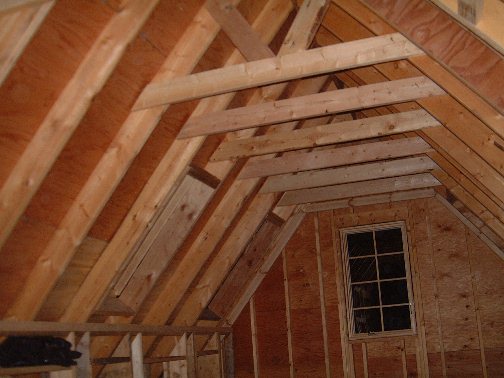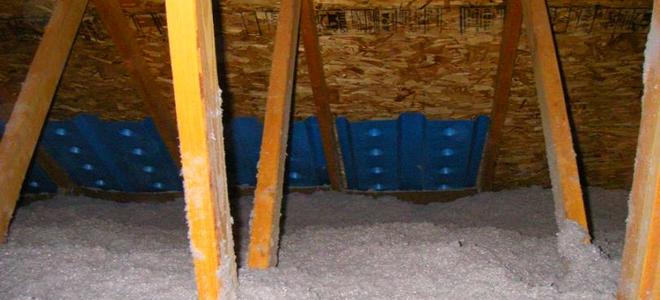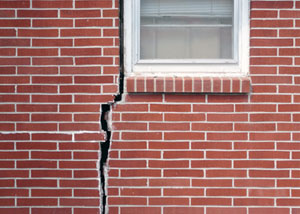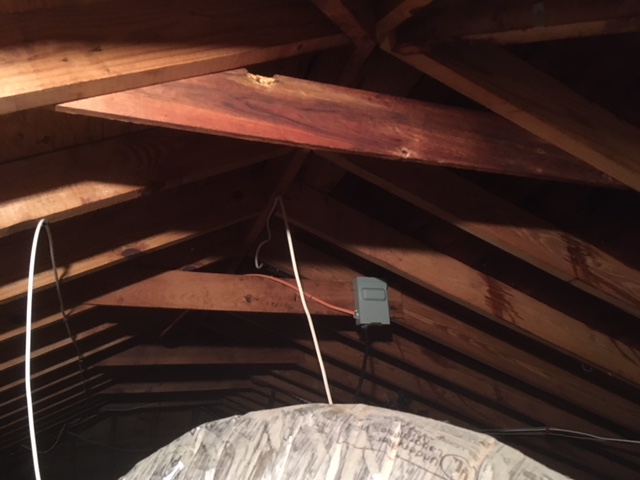Collar ties are important to note when doing a inspection. They are designed to hold the rafters dow against the ridge board and to help prevent rafter spread. inspectors should take note if there are no collar ties in the rafters.

Collar ties are important to note when doing a inspection. They are designed to hold the rafters dow against the ridge board and to help prevent rafter spread. inspectors should take note if there are no collar ties in the rafters.

Balloon framing is when the the use of long continuous framing members are utilized for framing. It was a practice that was widely used years ago, when long lumber was plentiful, but has since been replaced mostly by platform framing.
This hairline crack most likely came to be during the foundation’s curing process. It is not however a structural issue. An 1/8 inch or greater, the potential for concerning issues would arise. The ever aging truth of the matter is, is that concrete is going to crack no matter what.
I’m having a little bit of trouble figuring out how one would cap off a mansard style roof. I know that there have been products made to flash it around the perimeter. But as a former home builder I want that flashing to be the secondary line of defense. My only conclusions would require adding much needed bulk framing to support my idea. It’s up in the air one day it’ll come to me
Roof structure: Observed roof structure from the attic space indicates adequate truss placement and construction. Sheathing was intact without signs of water infiltration. Insulation was measured at 12 inches and included rafter or soffit vent panels to prevent soffit vent obstruction.

Collar ties vs rafter ties: Collar ties or collar beams are located in the top third of the rafter system to resist the separation of the rafters from the ridge beam. Rafter ties or located in the bottom third of the rafter system to resist the separation of the rafters from the top plate due to outward thrust caused by the weight of the roof system.
The deck pictured is of newer construction. It is cantilevered and appears to conform to the rule that the cantilevered edge cannot exceed 1/4 the length if the entire deck joist. Also it appears the the height of the support beam is high enough above the soil as to not be a concern for moisture contact. What cannot be determined from the photo is the safety in regards to the spacing of the vertical rails or the strength of such rails.
Cracks in the slab of the home are not uncommon. Many times the slab of the home are poured after the structure of the home has been completed. Often the slabs are poured without reinforcement in the concrete. Also, they are generally poured to a thickness of 4" which may not provide adequate strength to prevent cracks from occurring. However cracks which occur and have gaps that spread may indicate movement which shoud be viewed as a concern.
This picture shows how to properly Rafters we’re taking two fascia boards as you can see I slapped in and short not necessarily giving any support whatsoever. It also show signs of moisture and possibly dry rot due to the improper installation.
Collar ties versus rafter ties, difference between collar ties and rafter ties is that collar ties are installed in the upper 1/3 of the Rafters. Rafter ties are installed at the bottom 1/3 and usually right above the floor line this is what helps stop expansion and depression of the rafters. Incorrectly installed collar or rafter ties could potentially end up to be a big problem.
This vertical crack is a serious sign of possible foundation settlement or movement. It appears the crack has been patched and has opened up again, which is indicative of active movement in the foundation. Also, since the crack is located by a window, there is risk of significant water intrusion into the interior. Further assessment is recommended by a structural engineer.

Deck inspections are an important part of the overall home inspection, since it is estimated that only 40% of decks are actually safe. Important items to note are whether posts are connected to their footings so that the posts don’t lift or slip off, and whether lawn sprinkler systems or improperly placed downspouts are contributing to post decay.
High grading allows moisture to remain in contact with wall surfaces. The condition can result in material damage, and allow moisture intrusion. Inappropriate grade slope will compound moisture problems. The picture demonstrates how landscaping materials can contribute to high grade, poor slope conditions, and moisture retention. The mulch in the pictured case obstructed a number of weep holes. In addition to affecting wall ventilation, materials contacting weep holes provide a greater probability of moisture intrusion and creates a conductive environment for wood destroying insects.
This hip roof structure shows the collar ties proper installed in the top third of the rafter. The collar ties help resist uplift of the roof and separation of the rafters due to wind loads. The picture also shows the rafters correctly aligned where they join to the ridge.

Inspectors will frequently find cracks in the interior surface finishes of a house, typically a the top corners of doorways. This may indicate structural problems from foundation failure but it is more typically due to shrinkage of the wood used in framing. Wood can have a moisture content of 30% when cut, and should be dried to an equilibrium moisture content of 8% to 10% before it used in construction. As wood dries, the lumber’s dimension changes significantly along it’s grain which affects the length of the wood member. If high moisture lumber is used and it dries after framing a house, the change in length can cause stress cracks in the finished construction.
Crack in a outdoor retaining wall wall shows signs of movement from settling. Wall also shows signs of water seepage from improper or clogged weeping holes. Water from eaves has causes some washout of back fill. Some type of water diverions in recommended at point of ground contact on fill side of retaining wall.
The Mudjacking article covers the process of pumping slurry beneath a sunken concrete slab to raise it back to a level state. Mudjacking is an alternative to removing and replacing uneven flatwork or foundations that has experienced failure in underlying support. The process involves drilling small holes in the concrete, then pumping a material mixture such as cement or expanding polymer to fill voids and force the concrete back into place. The advantages of mudjacking include: efficiency; cost; speed; and environmental. Limitations include: further damage may occur in situations where the surface is spalling; where raised concrete is due to expansive clay soil; settlement cause is not addressed; and underling soil is not supportive. Mudjacking should be performed by a trained professional to avoid causing further damage. It is an inexpensive, fast, and clean alternative to repair sunken concrete.
In this photo you will notice a steel post holding up a laminated wooden beam. This beam spans the width of the basement from left to right. Due to the deflection in the beam, it should be looked at by a structural engineer to determine whether or not the beam is sized correctly for the homes weight.
There are several pros and cons for a homeowner to decide when it comes to aluminum siding as the protection for the home. It can be very durable and protect the house, but it can also be dented easily and it needs to have paint reapplied every 5 - 10 years.
An air admittance valve is a valve used for stack venting on plumbing. To eliminate the need for a passive exterior pipe, this valve can be used to protect the p-trap at the sink from siphonage. After noticing the pressure from our bathroom toilet vacuuming the necessary water from our p-trap in our sink and thus permitting a sewer like odor to emit, we installed an air admittance valve to act as a negative pressure vent in our sink pipe drain. Voila, no more odor.